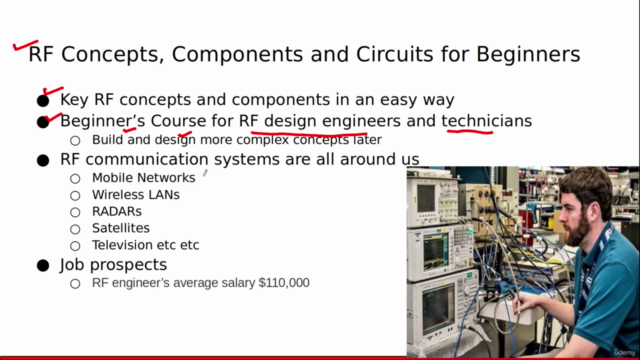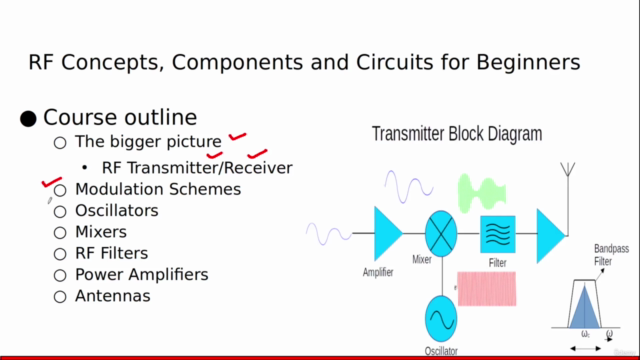RF Concepts, Components and Circuits For Beginners

Why take this course?
🚀 Course Title: RF Concepts, Components, and Circuits For Beginners
🧐 Headline: Dive into the World of Radio Frequency (RF) Technology! 📡
About this Course:
Unlock the secrets of the electromagnetic spectrum with our comprehensive beginner's course on RF Concepts, Components, and Circuits. This is your gateway to understanding the fundamental principles that govern the design and operation of devices using radio waves. Whether you're aspiring to join the telecommunications industry or simply fascinated by the intricacies of RF technology, this course will equip you with the knowledge you need to navigate the complex world of RF engineering.
📈 What You Will Learn:
-
Fundamentals of RF Systems: Get acquainted with the foundational concepts and applications of radio frequency technology.
- Introduction to RF systems
- Transmitter/Receiver Block Diagram
-
Mastering Modulation: Explore the various techniques used to transmit data over radio waves.
- Important Analog And Digital Modulation Schemes
-
Essential Electronics Concepts: Refresh your understanding of key electronics principles that are crucial in RF applications.
- Revision Of Some Basic Electronics' concepts
-
Precision Oscillators and Mixers: Learn about the devices that generate and manipulate radio frequency signals.
- RF Oscillators
- Mixer and its Applications
-
Signal Processing with Filters: Understand how to shape and control signals using a variety of filters.
- RF Filters
-
Amplifier Power and Efficiency: Discover the role of power amplifiers in boosting signal strength.
- Power Amplifiers
-
Antenna Fundamentals: Delve into the design and function of antennas, which are key interfaces between wireless devices and the RF environment.
- Antennas
-
Impedance Matching Techniques: Learn to maximize signal efficiency with impedance matching, VSWR, and reflection analysis.
- Impedance Matching, Reflected Power & VSWR
- S (Scattering)-Parameter
-
Advanced Impedance Matching with Smith Chart: Gain expertise in using the Smith Chart for optimal impedance matching.
- Smith Chart And Impedance Matching
-
Low Noise Amplifiers: Understand how low noise amplifiers enhance signal quality.
- Low Noise Amplifier (LNA)
-
Attenuators and Signal Control: Learn about the different types of RF attenuators and their applications in signal control.
- RF Attenuators and their Types
-
Introductory SDRs: Get an overview of Software Defined Radios, a powerful tool for modern RF applications.
- Introduction to Software Defined Radios (SDRs)
Course Structure:
This course is meticulously structured to provide you with a step-by-step learning experience. Each section is designed to build upon the previous one, ensuring a solid foundation in RF concepts before moving on to more complex topics.
- Section 1: Introduction to RF systems
- Section 2: Bigger Picture: Transmitter/Receiver Block Diagram
- Section 3: Important Analog And Digital Modulation Schemes
- Section 4: Revision Of Some Basic Electronics' concepts
- Section 5: RF Oscillators
- Section 6: Mixer and its Applications
- Section 7: RF Filters
- Section 8: Power Amplifiers
- Section 9: Antennas
- Section 10: Impedance Matching, Reflected Power & VSWR
- Section 11: S (Scattering)-Parameter
- Section 12: Smith Chart And Impedance Matching
- Section 13: Low Noise Amplifier (LNA)
- Section 14: RF Attenuators and their Types
- Section 15: Introduction to Software Defined Radios (SDRs)
Why Take This Course?
Whether you're a student, an engineer, or a hobbyist, this course offers a comprehensive overview of RF engineering. By completing this course, you will:
- Gain a thorough understanding of the principles behind RF signals and components.
- Acquire practical knowledge that can be applied to real-world applications in telecommunications, broadcasting, and beyond.
- Develop troubleshooting skills for RF systems and circuits.
- Enhance your ability to design efficient and effective RF solutions.
🎓 Who Should Take This Course?
This course is ideal for:
- Beginners in RF engineering looking to build a strong foundation.
- Electronics engineers seeking to expand their knowledge into the RF domain.
- Students pursuing degrees in electrical engineering or telecommunications.
- Hobbyists and enthusiasts interested in the world of radio waves and wireless communication.
Embark on your journey into the fascinating field of RF technology today! 🌟
Course Gallery




Loading charts...